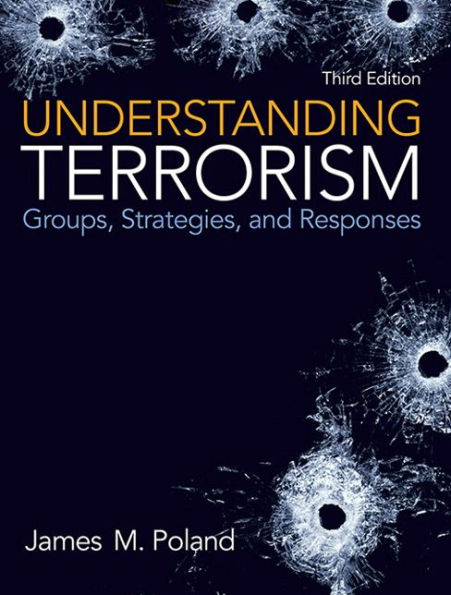Understanding Terrorism: Groups Strategies and Responses, 2e presents the essential lessons contained in the books, articles, and terrorist literature that have had the greatest impact upon the analysis of the terrorist strategy. The text is a synthesis in the respect that it brings together the divergent theories and methods that make up this dynamic field of scholarly inquiry. The book offers the various analytical approaches to the study of terrorism that identifies terrorist groups, reviews terrorist tactics, and examines police and governmental responses to reduce or eliminate the incidence of terrorism.
The text is written for all those who will have to deal with future terrorist events and who today are struggling to understand the motivation of contemporary terrorist groups. This list includes criminal justice students, professionals in the criminal justice system, and any student wishing to gain more information on the phenomenon of "terrorism." To be well informed about terrorism, students and professionals in the field must be familiar with the concepts, techniques, and theories drawn from political science, social psychology, and sociology as well as from the traditional criminal justice literature. The scholars who have assembled the knowledge on terrorism are obliged to relate their concepts of terrorism to the solution of the terrorist problem. The students and professionals in the field who must eventually confront the problem of terrorism are expected. to keep up with new developments in terrorist theory and strategies, and to possess special training, knowledge, and skills. Future trends indicate the necessity of increasing personal and scholarly awareness of the threat of terrorism to global peace. Thus, it is hoped that this book provides the information and knowledge to understand better the concept of terrorism.
However, terrorism must be kept in perspective. The terrorist threat is in reality a multiplicity of real and imagined threats, each originating from a different source and each presenting :a separate set of tactical and political problems. For example, the military .retaliatory bombing raid against Afghanistan for assisting in terrorist attacks against American targets is viewed as deterrent retaliation. At the same time, few policymakers would suggest that the U.S. military send F-111 bombers to attack the headquarters of the KKK, HAMAS, or Hizballah base camps in Southern Lebanon. In addition, most terrorists are not career criminals, insane fanatics, or government surrogates, but ordinary individuals driven to -violence by what they see as unacceptable social conditions or by radical religious political beliefs.
Clearly, the most confounding problem in the study of terrorism is arriving at a definition acceptable to all. Few people want to be called terrorists; terrorism is essentially what the other side has done. This is why there is no satisfactory political definition and no common academic consensus as to the essence of terrorism. For example, were the bombers of the Marine Compound in Beirut "terrorist criminals" or heroic "freedom fighters?" Which terms best describe the PIRA or the Tamil Tigers? Where there is political consensus, problems of definition are moot. Where there is no political consensus, definitions have a tendency to polarize differences. Ours are freedom fighters and commandos; yours are terrorist fanatics. So numerous are the definitions of terrorism proposed by scholars and policymakers that recently the focus of terrorism has shifted to the intimidation of "soft" civilian targets as an "unbiased" technique for defining terrorism. This textbook presents and compares several of the more popular definitions in the belief that each contributes to the growth of understanding terrorism.
The plan of the book is presented in the following manner. The fundamental concepts and theories of terrorism are summarized in Chapter 1. Chapter 2 briefly outlines the historical antecedents of "terrorism." In Chapter 3 the role of the media in contributing to the increase in terrorism is examined. Terrorist groups active in the United States are reviewed. In Chapter 4, the Palestine Question is reviewed and the structure and function of al Qaeda is analyzed. Chapter 5 outlines the "A" list or designated foreign terrorist organizations that pose a threat to the United States or its allies. Chapter 6 provides an overview of hostage-taking and negotiation. In Chapter 7 the reader is introduced to the techniques of explosive materials. The terrorist tactic of suicide bombings is explored in Chapter 8. Chapter 9 explains the analytic, political, legal, scientific, and behavioral responses that government policymakers have used to attack and solve the problem of terrorism. Finally, Chapter 10 attempts to look into the future and delineate potential areas of terrorism, such as nuclear terrorism and Islamic extremism. The influence of terrorism on democratic states is also analyzed in terms of changes that might be anticipated as a result of a prolonged campaign of terrorism in a democracy.
As with most controversial subjects, the author must wrestle with his own bias and prejudice. I have done my utmost to present an unbiased, balanced view of contemporary terrorism in the modern world. This project was undertaken at the request of criminal justice students who continually complained that the literature on terrorism was overwhelming and confusing. I only hope that I have not added to that confusion.
JP Sacramento





